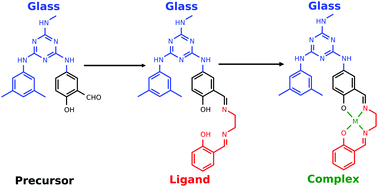Transition metal molecular glasses by design: mexylaminotriazine-functionalized salicylaldehyde imine ligands†
Abstract
Mexylaminotriazines are a novel class of small molecules capable of forming stable glassy phases. When covalently linked to a variety of small molecules, mexylaminotriazines possess the ability to introduce resistance to crystallization and yield stable glassy phases for various other moieties that are traditionally unable to readily adopt glassy phases. To date, this has been applied particularly to opto-electronic devices. However, there is limited information regarding the synthesis of glass-forming metal complexes. Herein, a library of salicylaldehyde imine derivatives incorporating mexylaminotriazine substituents were synthesized, from which respective complexes with various first-row transition metals were prepared. The resulting compounds were characterized and evaluated for their glass-forming properties. It was found that all synthesized ligands and complexes demonstrated the ability to adopt glassy phases; however, the metal centre was identified as having a profound impact on the glass transition temperature (Tg). Additionally, it was found that the incorporation of mexylaminotriazine moieties to ligand frameworks may present a reliable and predictable strategy for the introduction of glass-forming properties into a variety of metal complexes.



 Please wait while we load your content...
Please wait while we load your content...